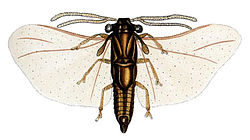| Elenchus koebelei | |
|---|---|
 | |
| Scientific classification | |
| Kingdom: | Animalia |
| Phylum: | Arthropoda |
| Class: | Insecta |
| Order: | Strepsiptera |
| Family: | Elenchidae |
| Genus: | Elenchus |
| Species: | E. koebelei |
| Binomial name | |
| Elenchus koebelei (Pierce, 1908) | |
Elenchus koebelei is an insect species in the genus Elenchus . It is a parasitoid of Prokelisia , found in Florida salt marshes. [1]